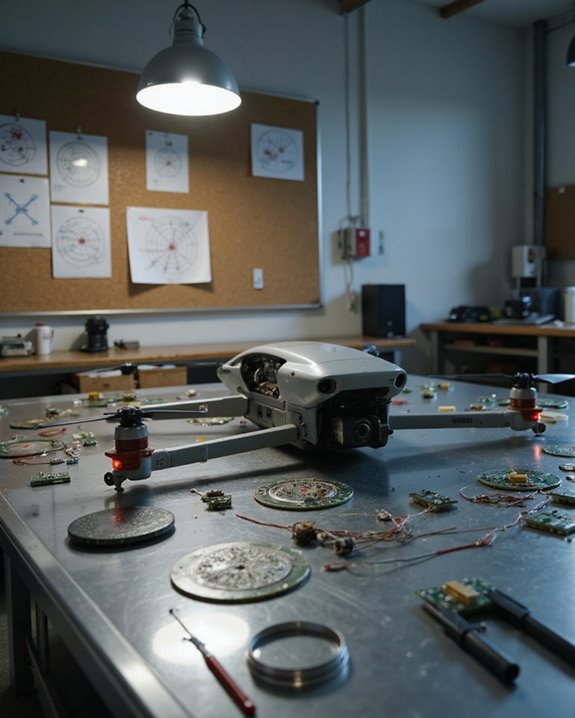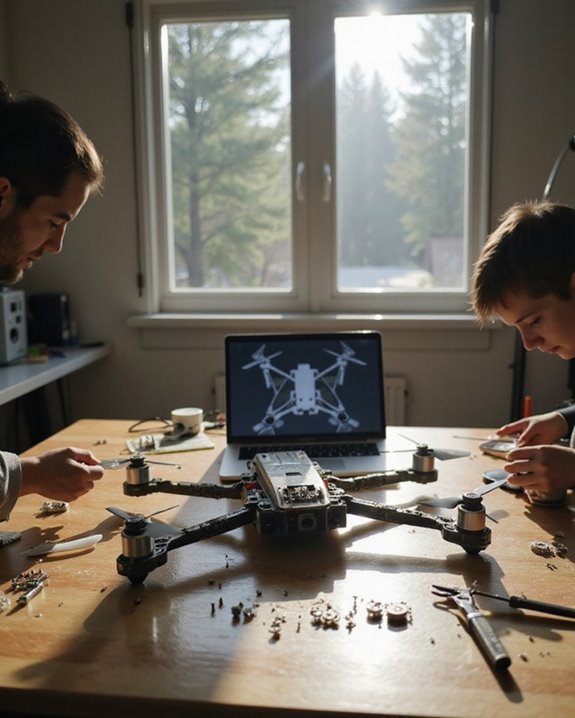A drone’s data link is its high-tech “walkie-talkie”—connecting the airborne segment, like the Airborne Data Terminal and omnidirectional antennas, to ground controllers with smart dashboards and secure antennas. Data links beam video, controls, and status info up and down, using tech like OcuSync and features such as anti-interference magic (think the Radiolink T12D, not wizardry). Without these components, flights would be, well, crash courses in chaos! Stick around, and you’ll see just how these parts keep drones buzzing along.
Key Takeaways
- The Airborne Data Terminal (ADT) on the drone manages RF transmission, signal processing, and integrates with navigation and autopilot systems.
- Omnidirectional antennas on the drone enable consistent data link communication regardless of flight orientation or maneuvers.
- The ground segment includes antennas, transceivers, and secure networks at ground control stations for reliable connectivity and safety.
- Data link components often use anti-interference technology and data encryption to ensure stable, secure communication in congested environments.
- Data links transmit control signals, telemetry, and real-time video using frequencies like 2.4 GHz and 5 GHz for robust bi-directional communication.
Primary Functions and Importance of Drone Data Links
When it comes to drones, data links are truly the unsung heroes of the sky! They quietly power everything from simple hobby flights to highly sensitive military missions. Historically, data links have evolved from basic radio controls to advanced digital channels, transforming drones from mere toys into essential tools for industries, science, and even disaster response. Without reliable data links, there would be no real-time video, no precise navigation, and definitely no pizza delivered by drone—imagine the economic impact of that! Data links enable secure command and control, instant data transmission, and robust security, helping drones adapt to new challenges and environments. These advancements boost market growth, create jobs, and spark new business models, all while keeping drones safely connected to their operators. Modern controllers utilize advanced technologies like OcuSync transmission to ensure long-range, low-latency communication vital for drone operations.
Key Components in the Airborne Segment
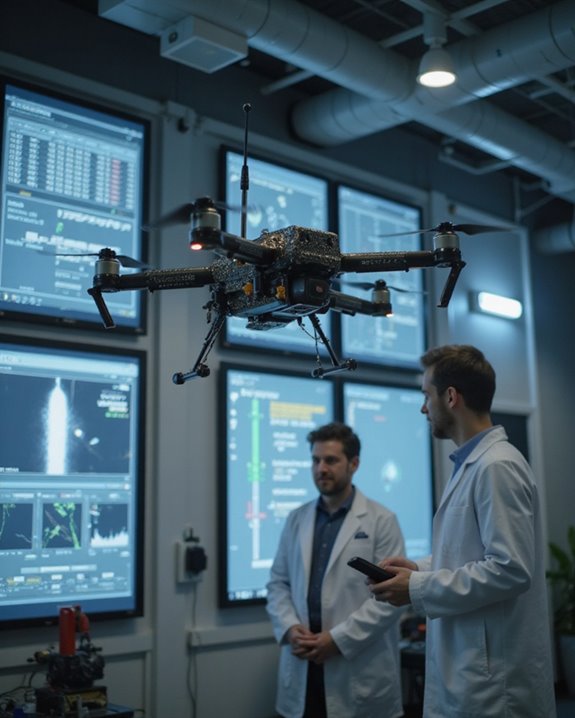
Imagine this: a drone soaring above your neighborhood, snapping photos or delivering a package, all while quietly relying on some pretty smart gear inside. The Airborne Data Terminal (ADT) is the heart of it all—handling data link management, juggling signals with its built-in RF receiver and transmitter, and acting as the drone’s “chat room” with the ground station. Component History shows ADTs have evolved from simple radios to sophisticated devices with onboard processors for real-time data compression, a huge leap thanks to modern Technology Trends! Antennas, often omnidirectional, let the drone talk no matter which way it’s facing, while RF components keep those signals crisp and secure. All these work together, linking seamlessly with navigation and autopilot systems—pretty cool, right? For example, advanced controllers like the Radiolink T12D use anti-interference technology to maintain stable transmission even in crowded RF environments.
Ground Segment Components and Roles
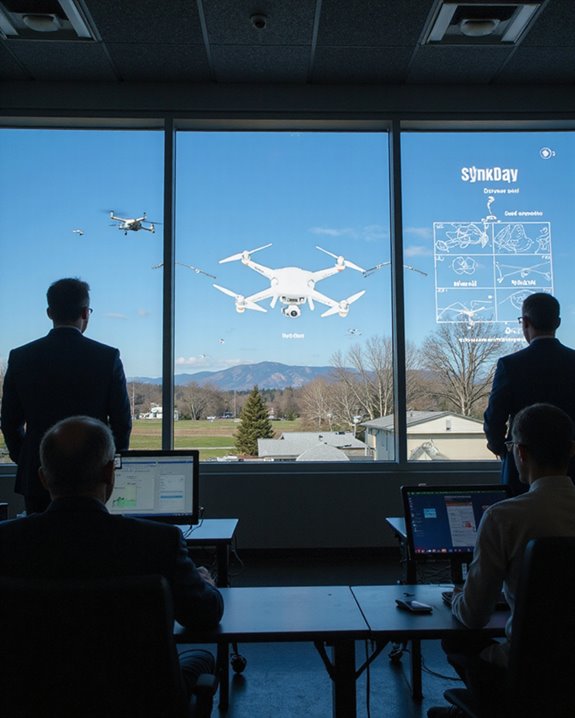
Ground segment components are the unsung heroes of any drone operation, working hard behind the scenes so drones can shine in the sky. Think of ground stations as the “nerve center”—they use antennas, transceivers, and secure networks to keep drones connected and safe. Choosing the perfect site for these stations isn’t just about good views; site selection impacts signal strength, safety, and even convenience for operators. Ground control stations give operators a user-friendly dashboard to control drones, analyze data, and share insights—sort of like a high-tech mission command. Meanwhile, mission control centers manage operations and provide technical support, while support facilities handle everything from launch pads to maintenance. Training programs are essential, too, ensuring everyone is ready for smooth, secure drone missions. Additionally, integrating an FAA Compliant Remote ID Module enhances real-time tracking and regulatory compliance for safer drone operations.
Applications in Civilian and Military Missions
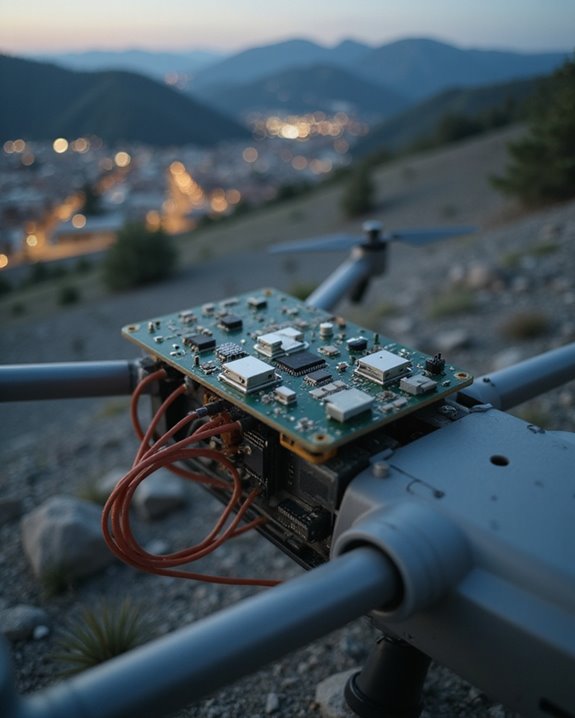
A world powered by drones is closer than you might think! Drones aren’t just flying gadgets—they’re changing lives on the ground. In civilian life, drones inspect bridges, monitor crops, and even deliver medical supplies, making work safer and faster. They help scientists track pollution or spot deforestation, all while keeping humans out of harm’s way. These Ethical Applications raise big Social Impacts, like job changes or debates about privacy—imagine your pizza delivered by a drone with a camera! In military missions, drones gather real-time intelligence, secure communications with heavy-duty encryption, and support soldiers with AI-powered reconnaissance. Their ability to operate in risky or urban environments means more safety for troops. Both worlds show drones’ powerful, evolving role in society—definitely not just toys anymore!
Attributes Defining Data Link Performance
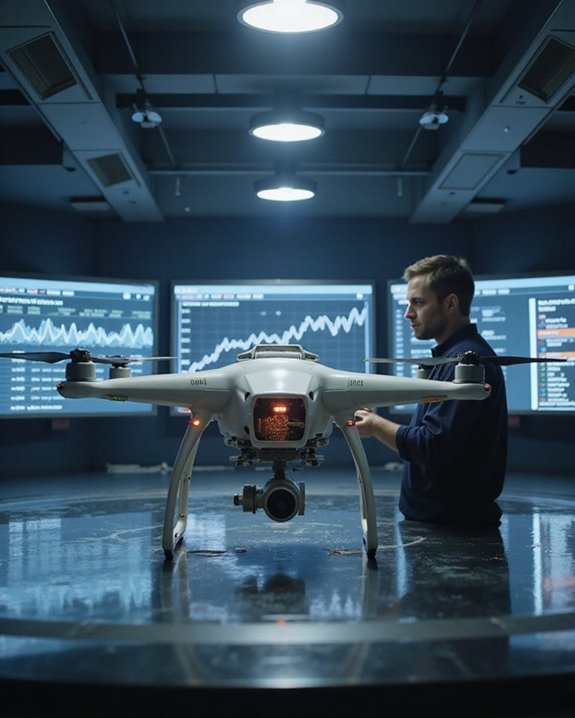
Data link performance is the powerhouse behind every successful drone mission, whether it’s streaming high-definition video from the sky or just sending a steady stream of control commands. Evolution Trends show us that today’s drones rely on throughput of about 4000 bytes per second for downloads, and 1000 bytes per second for uploads—impressive for such compact machines! Comparative Studies often highlight how 2.4 GHz and 5 GHz frequencies, like those found in Wi-Fi routers, handle video and control, while lower bands (900 MHz) can soar past 20 miles! Reliable data links need strong encryption, authentication, and a knack for dodging interference, jamming, and even bad weather. Metrics like RSSI, packet error rate, and SNR keep engineers up at night—nobody wants a drone lost in the fog!
Core Functions of Data Transmission
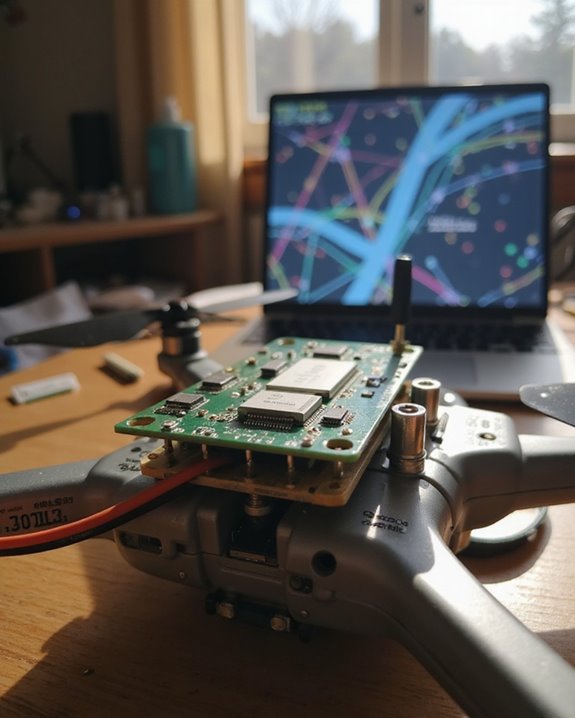
Ever wondered how drones seem so smart, zipping through the sky and sending back crystal-clear video like it’s no big deal? It’s all thanks to the core functions of data transmission! The data link doesn’t just handle video streaming—it’s also responsible for sending control signals, telemetry data (think altitude or battery life), and even sensor info from GPS or cameras. Data compression steps in to shrink big files, making sure nothing clogs up the connection and reducing network latency so messages don’t lag. Bi-directional communication is key—it means the drone can “talk” to the ground station and listen, too! With antenna arrays, satellite relays, and even 5G networks, the drone’s data highway stays fast and reliable, no matter the mission.
Implementation Challenges and Limitations
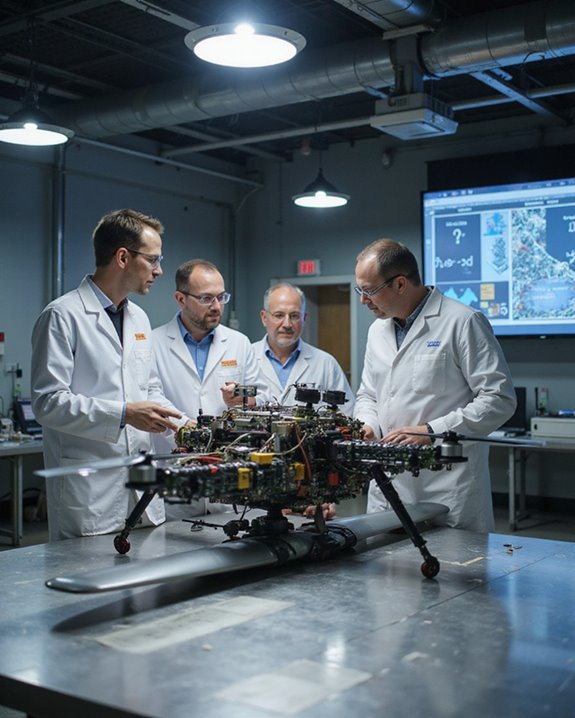
Even with all the cool tech powering drone data links, getting everything to work smoothly in the real world is no walk in the park! Imagine this: controlling drones miles away sounds awesome, but distance limitations and tricky weather like fog or wind can really mess things up. Regulations add more headaches—thanks to FAA rules, flying drones Beyond Visual Line of Sight (BVLOS) means jumping through a ton of regulatory hurdles. Budget constraints don’t help either; fancy features like satellite links are pricey, so most commercial drone teams can’t even consider them. Throw in challenges like interference, complex hardware and software compatibility, training needs, and tricky terrain—suddenly, implementing reliable data links feels like solving a Rubik’s Cube in a hurricane!
Ensuring Security and Reliability in Data Links
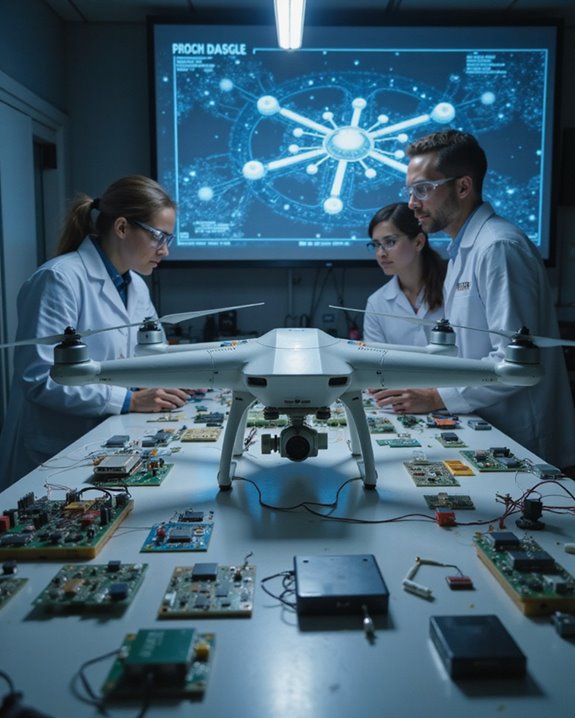
Of course, unpredictable weather and strict regulations might make drone operations feel like a wild rollercoaster ride, but nothing throws a wrench in the works quite like a security breach or a lost signal! Every drone enthusiast and operator knows that Privacy Concerns and Regulatory Compliance aren’t just buzzwords—they’re deal-breakers. That’s why experts recommend using strong encryption, like AES-128, and up-to-date protocols such as WPA3. Forget about old-school WEP; hackers love that stuff! Secure pairing, multi-factor authentication, and VPNs act like digital bodyguards. Tools like frequency hopping, tamper-proof hardware, and SDR-based signal monitoring keep drones flying safely and legally. Regular audits, real-time alerts, and adaptive frequency selection mean you’re ready to spot trouble fast—because data, privacy, and reliability always come first!
Frequently Asked Questions
How Do Weather Conditions Affect Drone Data Link Performance?
Much like Odysseus braving unpredictable seas, drones encounter Weather Effects that induce Signal Attenuation, causing data link disruptions. Rain, wind, and atmospheric changes can degrade signal strength, introduce latency, and even sever connections during adverse environmental conditions.
Can Data Links Be Upgraded After the Drone Is Manufactured?
Upgrade possibilities for drone data links exist after manufacturing, often through retrofit methods such as aftermarket kits. These upgrades can improve security and performance, though they may require technical expertise and careful compatibility assessments to implement successfully.
What Are Common Troubleshooting Steps for Data Link Failures?
Much like tuning a radio to find a clear station, technicians address data link failures by verifying antenna alignment, checking battery integrity, consulting error logging tools, updating software, and eliminating interference sources for restored, uninterrupted communication.
Are There International Standards for Drone Data Link Frequencies?
The current question addresses whether international standards for drone data link frequencies exist. While Spectrum Allocation is globally guided by ITU, Regulatory Compliance varies by country, and no unified international standard specifically for drone data link frequencies currently exists.
How Does Data Link Technology Impact Drone Battery Life?
Studies show data transmission can account for up to 30% of a drone’s power use. Battery optimization relies on signal efficiency—transmission method, data rate, and signal quality all critically influence how quickly a drone’s battery depletes.

